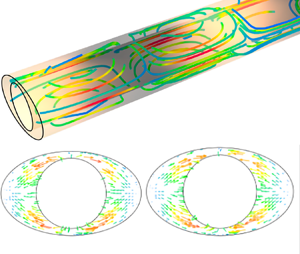Crossref Citations
This article has been cited by the following publications. This list is generated based on data provided by
Crossref.
Troyetsky, Daniel E.
Tithof, Jeffrey
Thomas, John H.
and
Kelley, Douglas H.
2021.
Dispersion as a waste-clearance mechanism in flow through penetrating perivascular spaces in the brain.
Scientific Reports,
Vol. 11,
Issue. 1,
Coenen, W.
Zhang, X.
and
Sánchez, A.L.
2021.
Lubrication analysis of peristaltic motion in non-axisymmetric annular tubes.
Journal of Fluid Mechanics,
Vol. 921,
Issue. ,
Sincomb, S.
Coenen, W.
Gutiérrez-Montes, C.
Martínez Bazán, C.
Haughton, V.
and
Sánchez, A.L.
2022.
A one-dimensional model for the pulsating flow of cerebrospinal fluid in the spinal canal.
Journal of Fluid Mechanics,
Vol. 939,
Issue. ,
Kundu, K.
and
Sarkar, U. K.
2022.
Analytical and numerical investigation of Poiseuille flow through semi-elliptic annulus.
Physics of Fluids,
Vol. 34,
Issue. 8,
Wan, Jiandi
Zhou, Sitong
Mea, Hing Jii
Guo, Yaojun
Ku, Hansol
and
Urbina, Brianna M.
2022.
Emerging Roles of Microfluidics in Brain Research: From Cerebral Fluids Manipulation to Brain-on-a-Chip and Neuroelectronic Devices Engineering.
Chemical Reviews,
Vol. 122,
Issue. 7,
p.
7142.
Bohr, Tomas
Hjorth, Poul G.
Holst, Sebastian C.
Hrabětová, Sabina
Kiviniemi, Vesa
Lilius, Tuomas
Lundgaard, Iben
Mardal, Kent-Andre
Martens, Erik A.
Mori, Yuki
Nägerl, U. Valentin
Nicholson, Charles
Tannenbaum, Allen
Thomas, John H.
Tithof, Jeffrey
Benveniste, Helene
Iliff, Jeffrey J.
Kelley, Douglas H.
and
Nedergaard, Maiken
2022.
The glymphatic system: Current understanding and modeling.
iScience,
Vol. 25,
Issue. 9,
p.
104987.
Kim, Daehyun
Gan, Yiming
Nedergaard, Maiken
Kelley, Douglas H.
and
Tithof, Jeffrey
2023.
Image analysis techniques for in vivo quantification of cerebrospinal fluid flow.
Experiments in Fluids,
Vol. 64,
Issue. 11,
Kelley, Douglas H.
and
Thomas, John H.
2023.
Cerebrospinal Fluid Flow.
Annual Review of Fluid Mechanics,
Vol. 55,
Issue. 1,
p.
237.
Vaidya, Hanumesh
Prasad, Kerehalli Vinayaka
Tripathi, Dharmendra
Choudhari, Rajashekhar
Hanumantha
and
Ahmad, Hijaz
2023.
Viscoplastic Hybrid Nanofluids Flow Through Vertical Stenosed Artery.
BioNanoScience,
Vol. 13,
Issue. 4,
p.
2348.
Gjerde, I. G.
Rognes, M. E.
and
Sánchez, A. L.
2023.
The directional flow generated by peristalsis in perivascular networks—Theoretical and numerical reduced-order descriptions.
Journal of Applied Physics,
Vol. 134,
Issue. 17,
Gan, Yiming
Holstein-Rønsbo, Stephanie
Nedergaard, Maiken
Boster, Kimberly A. S.
Thomas, John H.
and
Kelley, Douglas H.
2023.
Perivascular pumping of cerebrospinal fluid in the brain with a valve mechanism.
Journal of The Royal Society Interface,
Vol. 20,
Issue. 206,
Mukherjee, Saikat
Mirzaee, Mahsa
and
Tithof, Jeffrey
2023.
Quantifying the relationship between spreading depolarization and perivascular cerebrospinal fluid flow.
Scientific Reports,
Vol. 13,
Issue. 1,
Gjerde, Ingeborg G.
Kuchta, Miroslav
Rognes, Marie E.
and
Wohlmuth, Barbara
2024.
Directional flow in perivascular networks: mixed finite elements for reduced-dimensional models on graphs.
Journal of Mathematical Biology,
Vol. 89,
Issue. 6,
Winn, Aaron
and
Katifori, Eleni
2024.
Operating principles of peristaltic pumping through a dense array of valves.
Journal of Fluid Mechanics,
Vol. 989,
Issue. ,
Joshi, Ketaki
Diaz, Adrian
O’Keeffe, Katherine
Schaffer, J. David
Chiarot, Paul R.
and
Huang, Peter
2024.
Flow in temporally and spatially varying porous media: a model for transport of interstitial fluid in the brain.
Journal of Mathematical Biology,
Vol. 88,
Issue. 6,
Turkyilmazoglu, Mustafa
2024.
Corrections to long wavelength approximation of peristalsis viscous fluid flow within a wavy channel.
Chinese Journal of Physics,
Vol. 89,
Issue. ,
p.
340.
Nozaleda, Guillermo L.
Coenen, Wilfried
Haughton, Victor
and
Sánchez, Antonio L.
2025.
Arterial pulsations and transmantle pressure synergetically drive glymphatic flow.
Scientific Reports,
Vol. 15,
Issue. 1,
Li, Chenji
Dabiri, Sadegh
and
Ardekani, Arezoo M.
2025.
Perivascular interactions and tissue properties modulate directional glymphatic transport in the brain.
Fluids and Barriers of the CNS,
Vol. 22,
Issue. 1,
Li, Qingye
Li, Xinxin
Li, Yuxue
Song, Xueguan
Li, De
Zhang, Yanfeng
and
Peng, Yan
2025.
A hybrid two-way fluid-solid interaction method for intermittent fluid domains: A case study on peristaltic pumps.
Advanced Engineering Informatics,
Vol. 65,
Issue. ,
p.
103191.
